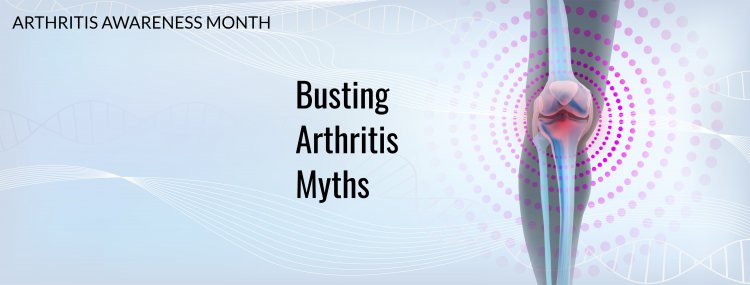Arthritis Awareness Month : Busting General Myths on Arthritis

Arthritis is very common but is not well understood. Actually, “arthritis” is not a single disease; it is an informal way of referring to joint pain or joint disease. There are more than 100 types of arthritis and related conditions. People of all ages, sexes and races can and do have arthritis, and it is the leading cause of disability in America. More than 50 million adults and 300,000 children have some type of arthritis. It is most common among women and occurs more frequently as people get older.
There are two main types: osteoarthritis (OA) and rheumatoid arthritis (RA). Common arthritis joint symptoms include swelling, pain, stiffness and decreased range of motion. Symptoms may come and go. They can be mild, moderate or severe. They may stay about the same for years but can progress or get worse over time. Severe arthritis can result in chronic pain, inability to do daily activities and make it difficult to walk or climb stairs.
- Arthritis only develops in older people
Let us bust this common myth straightaway. Yes, arthritis is more common in older adults, but it can affect people of any age. One study, which took data from the National Health Interview SurveyTrusted Source in the United States, found that doctors have diagnosed arthritis in 49.7% of adults aged 65 years or older. However, the researchers also reported that 30.3% of adults aged 45–64 and 7.3% of people aged 18–44 had an arthritis diagnosis. As mentioned above, RA tends to present in people aged 20–40. - All joint pains are arthritis
This is not true. Not all joint pain is arthritis, and not all joint discomfort is a sign that arthritis will develop later. There are many possible causes of pain in and around the joints, including tendinitis, bursitis, and injuries. - Exercise aggravates arthritis
Exercise is not generally an activity that people with arthritis need to avoid, although they should speak with their doctor before beginning a regimen. Exercise can help maintain range of motion and strength in the joints. - Nightshade vegetables worsen arthritis
Nightshade vegetables, which include tomatoes, eggplant, potatoes, and peppers, are embroiled in a long standing arthritis myth. Some people claim that these foods increase arthritis symptoms. There is no evidence that nightshade vegetables can worsen inflammation/arthritis symptoms. However, the Arthritis Foundation does recommend certain anti-inflammatory foods, including oily fish that are rich in omega-3, colorful fruits and vegetables rich in antioxidants, nuts and seeds, and beans. - Using cold water/ice can aggravate arthritis
This is not true. In fact, both ice and heat can soothe sore joints. According to Guy’s and St Thomas’s National Health Service (NHS) Foundation Trust in the United Kingdom: that people should use heat before exercise, when a joint is stiff, and when they experience pain. Cold can also relieve pain, and it might also be useful if the joint is inflamed, particularly if there is swelling after activity. - Arthritis is not preventable
This is a partial myth. It is not possible to prevent every case of arthritis, as some risk factors, such as advancing age, are not modifiable. However, people can eliminate or minimize certain risk factors to prevent the onset of arthritis or slow its progression. For instance, people with excess body weight have an increased risk of developing knee OA. Maintaining a moderate weight can lower arthritis risk.


 Admin
Admin 

























